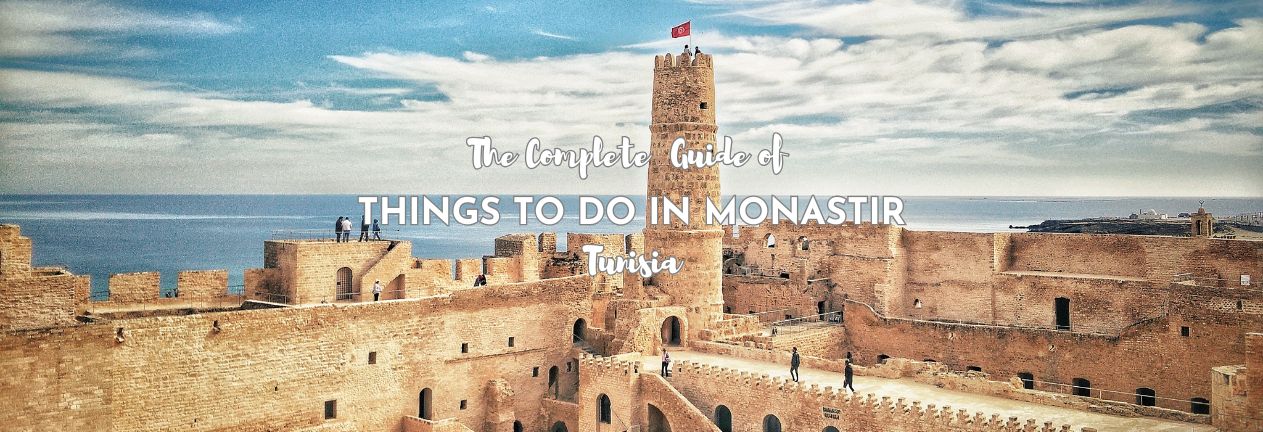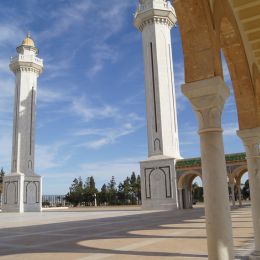Monastir, perched on Tunisia’s sun-kissed Sahel coast, is that rare blend of beachy ease and heavyweight history. The golden sands of Monastir’s beaches slope nicely into the turquoise waters of the Gulf of Hammamet, while behind them, a medina of whitewashed walls and blue doors vies for your attention. The Ribat fortress stands watch as it has for centuries, and the marina welcomes you for coffee with a side of sea breeze. Our things to do in Monastir guide provides practical how-to-get-here advice, details on the must-see sights, local eateries and eats, and where to rest your head. Whether you’re breaking up a Tunisia road trip or taking a day-trip from Sousse, Monastir is a beach town with an interesting cultural history.
THIS POST MAY CONTAIN COMPENSATED AND AFFILIATE LINKS MORE INFORMATION IN OUR DISCLAIMER
Most travelers pass Monastir on the way to somewhere “bigger” or “better” — and I think it’s all the better for that, and it’s definitely their loss. It’s an easily walkable city, with few of the touts and hassles that you might find in Hammamet or Sousse. It’s a fabulous place to climb the ramparts of the Ribat in the morning, explore and bargain for Berber scarves before lunch, and sit on the beach at sunset.
TOP THING TO DO
Explore the Hidden Corners with a Local
Explore the Medina, the Ribat and the Mausoleum of Habib Bourguiba, Tunisia’s father of independence. This is a fabulous way to learn about the history of Monastir and find the places that most won’t.
Where is Monastir, Tunisia
Monastir sits on a small peninsula on Tunisia’s central eastern coast. It’s part of the Sahel region and is tucked between Sousse to the north and Mahdia to the south, with the Mediterranean protecting it on three sides. It’s a bit of a curious mix of a working fishing port, some resorts benefiting from the breeze from the Med, and a good dose of history on every corner. Add to that it’s easy to reach from places like Sousse, and you’ve about got it all.
How to Get to Monastir
Getting here is easy. You can fly direct into Monastir’s own airport, ride the Metro from Sousse or Mahdia, or get here on an intercity bus. The coastal highway makes it an easy drive, too. However, once you arrive, the compact center and it’s an incredibly walkable city. There’s more on the different forms of transport in Tunisia in my guide here.
If you’re coming down from Sousse, then my guide with all the options, ticket costs and transport is here.
Flying to Monastir
Monastir Habib Bourguiba International Airport (MIR) is just 9 kilometers (5.5 miles) from the city, so if the beach is your thing, you could be on it within 30 minutes of landing! From the terminal, grab a taxi, pre-book a pickup from your hotel, or hop on the Sahel Metro (yes, there’s a stop at the airport!) for a cheap, scenic route straight into town.
PRACTICAL TRAVEL TIPS
- 🛡️ Get Travel Insurance: Civitatis includes medical expenses, repatriation, theft, luggage delays. No deductibles or upfront payments. Get a quote here.
- 💰 Read about the Currency in Tunisia and ATM fees.
- 🔌 Check out Tunisia’s plug, socket & power situation.
- 📶 Internet, maps and data on the go. eSims for Tunisia
Taking the Train to Monastir
The Sahel Metro, its light rail, not a subway or underground, is the easiest and most scenic way into Monastir from Sousse or Mahdia. The city’s main station, Gare de Monastir, is smack in the center. If you’re coming from Tunis, you’ll need to change in Sousse, but it’s very straightforward.
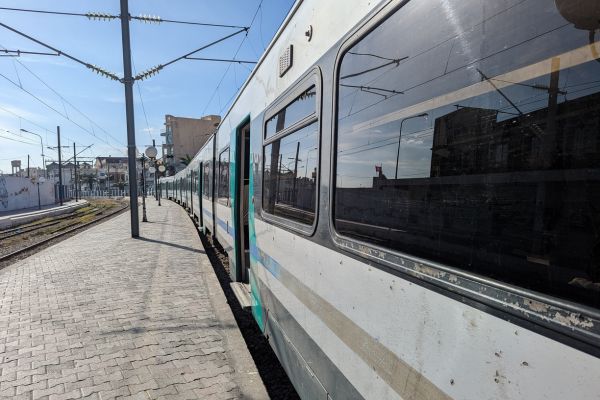
Trains are no-frills and slow, so grab a window seat for views, as the track follows the coast down. Tickets are cheap and sold at stations or on board (pay the conductor in cash). There’s no need for seat reservations.
Taking a Bus or Louage to Monastir
Buses and louages (shared minibuses) connect Monastir with Sousse, Mahdia, Kairouan, (my guide to Kairouan is here) and further afield. The louage station in Monastir is about a block from the train station. Louages tend to leave when full, so there’s no exact timetable, but you won’t wait long. It’s always best to start your travel earlier in the morning, and you spend less time waiting around. Buy tickets at the station; luggage usually goes in the back or on the roof. The ride isn’t as scenic as the train, but it’s quick and budget-friendly. A louage is a peak local experience and you’ll need cash for it. My guide to cash in Tunisia is here.
Driving a Rental Car to Monastir
Driving here is a doddle if you’re used to Mediterranean roads. The A1 motorway from Tunis takes about three hours; from Sousse, it’s very quick, you’ll probably spend longer looking for parking than driving!
The road signs are in Arabic and French, and yes, it’s a city, but traffic is calmer than in big cities, and coastal views are a bonus. Street parking is free in many spots; near the marina and main sights, expect a small fee.
Why come to Monastir?
Monastir is actually a good way to experience Tunisia for beginners. There are beaches, a cinematic fortress, aka the Ribat, a medina where you can look, touch, and enjoy without too many hard sells, and some great seafood that comes in fresh each day.
What to See and Do in Monastir
You’ll be glad to know that there’s not a hugely long checklist of things to see and do in Monastir. Pick the bits you’re interested in, and ignore the rest, or skip through the highlights and head back to your hotel for sunset views. Here’s where to start.
The Ribat of Monastir
I’d start here, because I like to get the historic stuff done first, it’s my favourite, and to be fair, the light is better for photos earlier in the day. The Ribat of Monastir is part fortress, part time machine. Built in 796, it’s a warren of courtyards and staircases that seem to lead you further back in time with each turn. The current iteration of Monastir’s Ribat dates from 1970, when it underwent mass restoration. They’ve done a pretty good job!
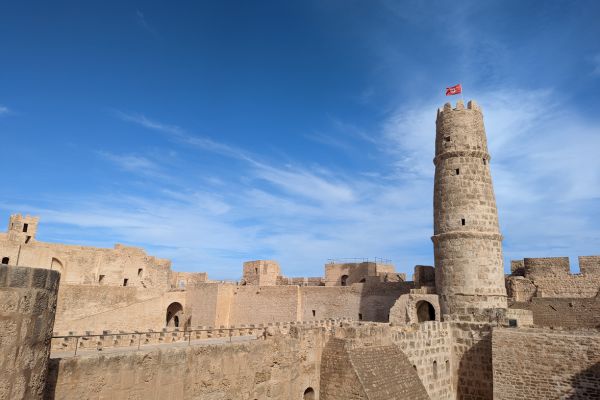
The Ribat was a monastery in the 8th century and used by soldier monks to both pray and fight invaders. Legend has it that if you held the Ribat for 3 days, then your place in paradise was guaranteed. You’ll have to put your paradisical plans on hold, as it’s open only from 08:30 until 17:30 daily.
The watchtower climb is a must — from the top, you’ll see the sea, the medina, and a vast cemetery with rows of white and sand-colored graves. Inside, a small museum holds Islamic art and everyday relics. For the Monty Python fans out there, this is where parts of Life of Brian were filmed. The most famous scene filmed here was when Pontius Pilate (Michael Palin) states that he will “Welease Woger!” – there’s more of the filming locations here.
Entry is just 8 TND for adults, and there are toilets here too.
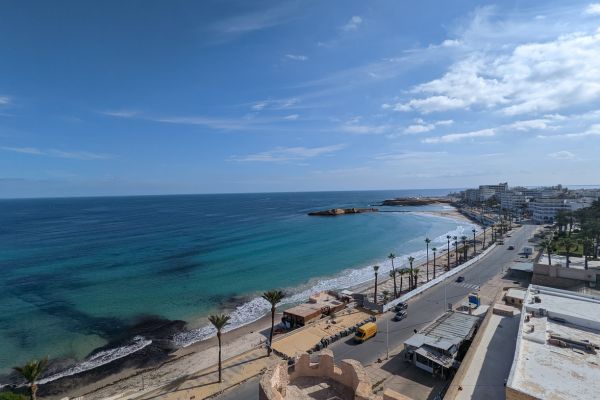
See the Mausoleum of Habib Bourguiba
You’ll spot the Mausoleum long before you reach it — the gold dome and twin minarets shine at the end of a rather grand avenue. Inside lie the remains of Habib Bourguiba, Tunisia’s first president, resting in marble splendor. He’s known as Tunisia’s father of independence, and this mausoleum was built on the exact spot where his parents were buried.
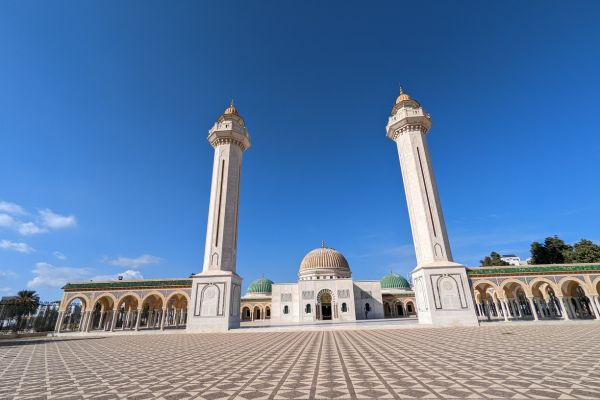
It took 20 years to build the mausoleum, materials including gold, marble, and wood from olive trees. You’ll find glass cases displaying Habib Bourguiba’s personal effects: a walking stick, photographs, and even his reading glasses. Entry is free, but there’s security to come through before you enter. The surrounding esplanade is a pleasant stroll in itself.

Monastir’s Marina
There are yachts here, fishing boats, and delightful palm-lined promenades for slow and easy walks. It’s an easy place to stop for coffee at one of the waterfront cafés. If you’re staying in Monsatir, then the Marina apartments are a perfect place to stay for their picturesque balconies and being on the doorstep of great seafood. The marina has berths for nearly 400 boats, and claims 100% occupancy in recent years, a great mix of nationalities and types of boats. It’s a great place for people watching and a mix of people.
Visit the Great Mosque
The Great Mosque dates back to the ninth century, but was expanded in the eleventh century, when the columns and arched vaults were added. The mihrab was also started at this time. Expansion continued with a square-based minaret and two naves between 1229 and 1574 – the Hafsid era. The mosque wasn’t completed until the 18th century, when a hallway was added on one of the exterior facades.
There’s no dome on top of the mihrab at this mosque, which makes it quite rare.
Check for prayer times as it’s closed to non-Muslims during prayers. Take a scarf for your hair if you’re female, and of course, both genders should wear respectful clothing if you do enter.
Explore the Medina in Monastir
Monastir’s medina is fabulous. Not too big, not too hectic, just right. There are whitewashed walls, blue shutters, and cobbled lanes wrapping around a combination of shops and stalls selling pottery, Berber blankets, and leather sandals. You’ll have walked through it to get from the train station to the Ribat, so just turn around and go back!

Try the local food in Monastir.
Monastir’s food scene is an edible adventure on the Mediterranean — fresh fish, grilled meats, couscous that actually tastes of something, and sweets sticky enough to glue your fingers together. Tunisian cuisine around here relies on the heat of harissa, olive oil richness, and the tang of preserved lemon.
You’ll want to try couscous with a small fish called shirkaw (best during the summer months); if it’s not in season, opt for any type of peppered fish. Lamb couscous, cumin-stewed meat (Kammounia), and Mermez are also local dishes.

For a relaxed drink and people-watching, head to a traditional tea house like Restaurant El Medina, where the mint tea comes in glass cups so hot you’ll need to sip cautiously. For a proper meal, Le Pirate at the old Port is a great option and continues to get super reviews.
How long to spend in Monastir
One full day is enough to see Monastir’s highlights without feeling rushed. In the morning, explore the Ribat and Mausoleum. In the afternoon, take a marina stroll, shopping or window shopping in the Medina, and a food stop.
When to visit Monastir
The best months are April–June and September–October, when it’s warm enough for the beach but cool enough for sightseeing. July and August are peak heat and crowd time, and the winter months are quieter, with milder days and occasional showers. We were here in late November and toted a lightweight fleece most days.
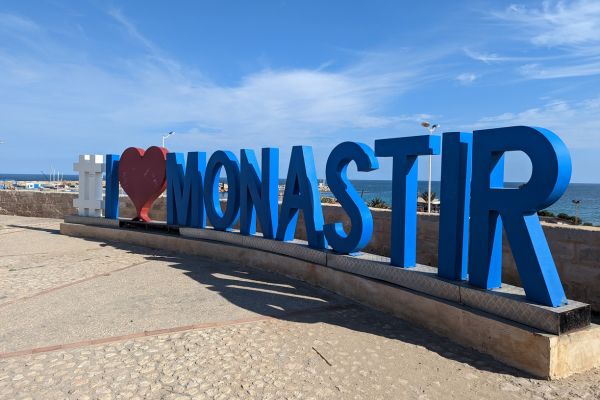
Where to Stay in Monastir
Monastir’s size means you’re never far from the beach or the medina — the real choice is whether you want resort comforts or authentic old-town charm.
- Good beach, pool, and entertainment option – Iberostar Kuriat Palace – Modern resort on a private stretch of sand, with multiple pools, spa, and evening entertainment. Perfect for unwinding after sightseeing.
- In the heart of the medina with a pool – Dar Benti – Traditional guesthouse with a courtyard pool, beautifully tiled interiors, and friendly hosts. Steps from the Ribat and local markets.
- Super views at the marine + great facilities – the Marina Apartments are a fabulous self-catering option with super marine views and breezes.
TUNISIA TRAVEL RESOURCES
AIRPORT TRANSFERS
24/7 pickup & drop off. Trusted, local English speaking drivers. Prebook & prepay online with cards.
Book a Transfer
HOTELS AND APARTMENTS
See choices here
Sea view rooms? Budget rooms? Need a washing machine? The best choice of hotels & apartments.
TOURS & ATTRACTIONS
Most excursion choices, small group tours, skip-line tickets, free cancellation and top local guides.
Top options here.
CAR RENTAL OPTIONS
Choose cars here
Best choice of vehicles, automatics, large or small cars, child seats. Book early for more options.
Final Words on Visiting Monastir, Tunisia
Monastir doesn’t exactly scream “come visit me”, but to be fair, that’s one of the reasons that we went. It feels like a real place where real people live, not where the tourists and locals are segregated. They don’t get a huge number of international visitors, and I think it’s all the better for it. Come for a day, a day trip from Sousse or even further afield, and enjoy a slow day in Monastir.
ASocialNomad is a participant in the Amazon Services LLC Associates Program, an affiliate advertising program designed to provide a means for sites to earn advertising fees by advertising and linking to amazon.com, amazon.co.uk, and amazon.ca. Amazon and the Amazon logo are trademarks of Amazon.com, Inc. or its affiliates. As an Amazon Associate, I earn from qualifying purchases.
